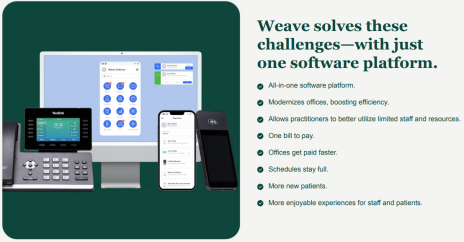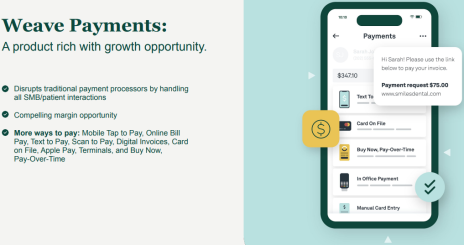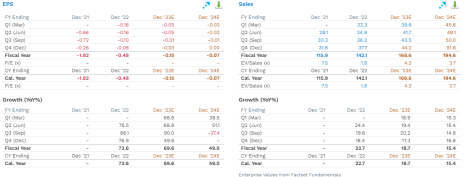The Big Idea
There are more than 30 million small and medium-sized businesses (SMBs) in the U.S. That adds up to roughly 99% of all businesses!
Yet while they are the backbone of the U.S. economy SMBs are often in no man’s land when it comes to business management software.
They’re too big to use consumer-oriented software and too small to use expensive and complex “enterprise-scale” software solutions.
SMBs need software designed specifically for them. This is especially true for customer-facing applications where properly managing a relationship with contextual, personalized messages can mean the difference between booking revenue or missing out.
Radio silence just doesn’t work anymore.
Because of a dearth of industry-specific solutions, many SMBs struggle with a patchwork of clunky, generalist solutions that wind up distracting staff and creating a disjointed experience for customers.
Today we’re jumping on a small software company that’s created a customer experience and payments platform specifically for the specialized SMB healthcare market.
The company doesn’t aspire to serve the massive healthcare networks out there. That’s not its sweet spot.
Rather, management sees an overlooked opportunity among the tens of thousands of dentistry, optometry, veterinary and other specialty provider offices out there.
Many of these players are beginning to see how a simple and efficient communications and payment platform can help them grow and retain customers.
In a world where small businesses have struggled for nearly two years through rising interest rates and increasingly cost-conscious consumers, this company’s results show there’s still intense demand for best-of-breed software.
This is its story.
The Company
“We believe that in most service-oriented businesses … the key to success isn’t measured in dollars ... Revenue is a byproduct to building real customer relationships ... Weave’s platform makes this interaction as seamless and as natural as possible by providing a personal touch ...” – Weave Co-Founder and CEO Brandon Rodman, 2018
Weave (WEAV) is a small software company that’s developed a customer experience and payments platform specifically for small and medium-sized healthcare businesses.
The platform, which is centered around a proprietary VoIP (voice over internet protocol) phone system, helps healthcare practitioners and office staff attract, engage and retain customers, thereby driving revenue growth, customer loyalty and operational efficiency.
Weave allows these small businesses to get rid of the patchwork of disjointed systems for payments, phone systems, emails, forms, scheduling, etc. that often lead to errors, costly inefficiencies (including more staff) and poor customer experiences.
Most of Weave’s current customers operate dental, optometry, veterinary and medical practices. Armed with the company’s platform they are able to better automate tasks, keep schedules full, get paid faster and collect more reviews.
The key offerings of the platform include payments, texting, scheduling, reminders, reviews, phones, insurance verification, digital forms and more, all woven (hence the company name, Weave) together into one easy-to-use platform.
According to management, Weave-powered offices schedule nine more patients a week after joining, the text feature saves an average of nearly three hours per day, and customers boost revenue by an average of $3,708/month by avoiding no-shows and cancellations.
The integrated digital payments solution is especially attractive for customers as tracking down post-visit payments (40% of revenue for many practices) can be a time suck for staff, and accounts payable balances can drag out for months.
Weave was founded by Clint Berry, Brandon Rodman and Jared Rodman in September 2008 and is headquartered in Lehi, UT. It has a market cap of $913 million.
The image below shows many of the company’s major accomplishments on the way to growing to over 30,000 customers in the roughly twelve years since its first solution for dentists was launched in 2011.
The Platform & Solutions
Weave’s platform is built on cloud-native technologies that leverage the infrastructure and platform-as-a-service offerings from Google Cloud and Amazon Web Services.
Customer-facing experiences (texting, email, reminders, etc.) are built on this platform and integrated with Weave’s proprietary VoIP phone system to create a truly seamless customer experience.
The cloud-based phone system was designed in-house using advanced business phones that are configured and automatically updated through the cloud. A dedicated security team leverages a variety of security technologies to monitor and respond to events, and data flowing through public networks is encrypted.
The image below from Weave’s Investor Slide Deck shows the current lineup of customer experience offerings.
Weave Payments is an increasingly relevant solution with clear benefits to customers and significant revenue and profit growth implications for Weave. Currently, 20% to 25% of new customers sign up for payments. The company has a partnership with Affirm (AFRM) that allows patients to get treatments and pay over time.
Weave has over 30,000 customer locations and integrates with over 75 partners (CRM, PMS, ERP, etc.), including the Henry Schein One/Dentrix Ascend platform for dentists (100,000 customers).
There are no long-term commitments and pricing is clear and simple, offered through three plans: Essentials, Pro and the top-tier Weave Elite (+$700/month).
Growth Initiatives
Grow Target Market to include Specialized Medical: Current customers (dental, optometry, veterinary practices) represent a roughly $2 billion market. Weave is expanding integrations to support specialized medical practices (family and general practice, medical aesthetics and plastic surgery), an incremental $3 billion market opportunity (i.e., $5 billion total addressable market).
Multi-Location Opportunity: Weave sees multi-location practices as a natural extension and will release solutions for this market in 2024. The integration with Dentrix Ascend (cloud-based practice management) is a clear sign of progress here.
Sales Efforts Ramping Up: The growing salesforce is becoming more productive through both in-person events and digital marketing, onboarding times are getting shorter and some customers who left are coming back. The evidence of this momentum is showing in revenue growth (has accelerated for three straight quarters), average revenue per location and higher average selling prices (Weave Elite is the best-selling bundle). The trends suggest demand for Weave’s specialized software can drive growth, even in a mediocre SMB economy.
3rd Party Wellness Form Disruption About Over: In late 2021 Weave began to change from a 3rd party wellness form for patient information from mConsent to its own Digital Form. This change has caused a variety of disruptions impacting net revenue retention (trailing twelve-month NRR is 95%) but management says it’s on the other side of the worst of it and NRR should grow in 2024.
Operational Efficiencies & Trend to Profitability: Several efficiency efforts – from hardware cost reductions (leasing instead of buying equipment) to cloud infrastructure efficiencies – are helping to improve gross margins and free cash flow. With gross margin expanding for seven consecutive quarters (from 57.4% in Q4 2021 to 69.3% in Q3 2023) and greater revenue scale, Weave is on the cusp of delivering its first quarters of adjusted EPS profits at some point in 2024. This transition should be welcomed by investors, just as the change to positive free cash flow was earlier in 2023.
The Business Model
Weave generates revenue from recurring fees for software subscriptions and payments (96% of revenue), hardware/phone systems (3% of revenue) and customer onboarding (1% of revenue). Gross margin on software and payments is around 74%, while hardware and onboarding lose money.
The Bottom Line
Revenue grew by 22.7% in 2022 and is on track to grow by 18.7% ($168.6 million) in 2023. That assumes Q4 sales meet consensus expectations and grow by at least 17.3% ($44.2 million). That appears more than likely given the company’s history of beating expectations and management’s increase to full-year revenue guidance at the time of the Q3 2023 report on November 1.
On the bottom line, Weave has not yet turned profitable, but the transition should happen at some point in 2024. In 2022 EPS was -$0.48 and assuming a $0.03 loss in Q4 (consensus expectation), EPS in 2023 will be -$0.15.
Looking into 2024, Weave should grow revenue by at least 15.5% to $195 million and slash the EPS loss by half, to around -$0.07. The transition to profitability is currently expected in Q4 2024, but given that just a few pennies per quarter could swing the pendulum here, I wouldn’t be remotely surprised if it happened earlier.
Weave has $10 million in long-term debt and $118 million of cash and short-term investments as of September 30, 2023.
Risk
- Efforts to attract & retain customers in such a specific market may fail.
- Market expansion plans (i.e., specialized medical) may not pan out.
- New product development initiatives may miss the mark.
- Margin expansion trend may fizzle out and curb profit growth trend.
Competition
Competition comes from a host of companies offering CRM, payments and UCaaS solutions such as Freshworks (FRSH), HubSpot (HUBS), Monday (MNDY), RingCentral (RNG), Block (SQ), 8x8 (EGHT) and Twilio (TWLO). However, there are a number of smaller, more specialized private companies as well, including Doctible, NexHealth, RevenueWell, Mindbody and Demandforce, among others.
The Stock
Trading Volume: Three-month average daily volume is 305,000 shares. We shouldn’t have a major impact on shares.
Historical Price: WEAV came public at 24 on November 11, 2021, near the end of the bull market. Shares fell to almost 3 by mid-2022. The next 10 months were better, but WEAV was still just at 4 in May 2023. The Q1 earnings report on May 5 was a turning point, catalyzing a rapid ascent to 12.4 by July. After the Q2 report on August 2, WEAV trended lower, ultimately bottoming at 6.7 on October 30. The Q3 report (November 1) drove another rally and WEAV trended consistently higher through Christmas. The stock has been trading in the 11 – 12 range for the last six sessions.
Valuation: WEAV’s 2024 EV/Revenue multiple is 4.5, below a peer group average of about 6.5. The stock’s multiple should expand toward that of the peer group as the story gets out there and if/as management makes progress on its growth initiatives.
Buy Range: Expect to buy in the 10 to 12.5 range over the next couple of weeks. There is overhead resistance at 12.5 from last summer and a break above that would be very bullish. The 25-day line at 10.6 (9% lower) should offer a solid buy point if the stock gets there. The 50-day line at 9.3 (24% lower) would be a place to reassess if WEAV were to fall that much. With the market acting a little iffy early in 2024 an WEAV approaching overhead resistance we will start with a half-sized position. BUY HALF
The Next Event: Q4 2023 earnings around February 28.
Current Recommendations
| Ticker | Stock Name | Date Bought | Price Bought | 1/3/24 | Profit | Rating |
| ATEC | Alphatec | 4/10/23 | 15.7 | 14.1 | -10% | Buy |
| BRZE | Braze | 8/3/23 | 42.3 | 48.2 | 14% | Hold |
| BBW | Build-A-Bear Workshop | - | - | - | - | SOLD |
| DCBO | Docebo | 12/7/23 | 44.6 | 44.3 | -1% | Buy |
| ENVX | Enovix | 10/6/22 | 20.4 | 11.7 | -42% | Buy |
| INTA | Intapp | 1/4/23 | 25.7 | 36.5 | 42% | Buy |
| LQDT | Liquidity Services | 11/2/23 | 19.2 | 17.5 | -9% | Buy |
| RELY | Remitly | 9/7/23 | 24.7 | 18.7 | -24% | Buy |
| WEAV | Weave Communications | 1/4/24 | NEW | 11.3 | NEW | Buy A Half |
| TMDX | TransMedics Group | 7/7/22 | 34.1 | 74.9 | 120% | Sold 3/4, Hold 1/4 |
Please email me at tyler@cabotwealth.com with any questions or comments about any of our stocks, or anything else on your mind.
Glossary
Buy means accumulate shares at or around the current price.
Hold means just that; hold what you have. Don’t buy, or sell, shares.
Sell means the original reasons for buying the stock no longer apply, and I recommend exiting the position.
Sell a Half means it’s time to take partial profits. Sell half (or whatever portion feels right to you) to lock in a gain, and hold on to the rest until another ratings change is issued.
Disclosure: Tyler Laundon owns shares in one or more of the stocks mentioned. He will only buy shares after he has shared his recommendation with Cabot Small-Cap Confidential members and will follow his rating guidelines.
The next Cabot Small-Cap Confidential issue is scheduled for
February 1, 2024.






